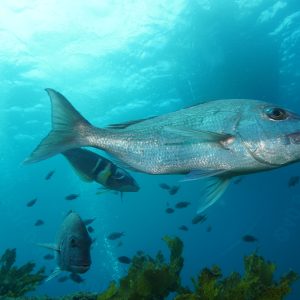Father Christmas or rather Shane Jones, the Minister for Oceans and Fisheries, has delivered a generous gift to quota owners in the Snapper 8 fishery on the west coast of the North Island – a 640 tonne increase in commercial catch. Meanwhile recreational fishers have been left with coal in their stockings.
The new Snapper 8 Total Allowable Commercial Catch (TACC) is now an eye watering 2240 tonnes, that’s over 2.2 million kilos of snapper that can be commercially harvested every year. And, the majority of this catch will be exported, leaving few benefits for Kiwis hoping for a nutritious meal.
Even with the Māui dolphin exclusion zone, bottom trawling is still the primary form of commercial fishing on the west coast. The major concern is that the TACC increase means more trawling, putting Māui dolphin, seabirds and other species such as trevally, gurnard, John dory and tarakihi at risk.
Given that New Zealand is bound by international obligations to protect endangered species, the prospect of increased trawling risks more frequent encounters with Māui dolphins that have recently been sighted outside of the trawl exclusion zone.
Shane Jones’ decision is far from precautionary when compared to David Parker’s brave move in 2021 to only increase the west coast snapper limit for commercial fishing by 300 tonnes and review it in three years. That decision has contributed to a healthier fishery today. Now the current Minister wants to fish it back down.
The majority of commercial fishing interests supported the excessive increase proposed by Fisheries NZ. Meanwhile, LegaSea collaborated with the New Zealand Sport Fishing Council and various other organisations to submit in support of a more conservative catch increase of 250 tonnes and a review in three year’s time.
The review is important because the effects of more trawling on other vulnerable species that are caught alongside snapper must be monitored.
The Minister’s decision sends a clear message to all of us – if there’s more snapper on the west coast they should be commercially harvested. But why is it so hard to just leave more fish in the water?
If the snapper populations along the west coast are as abundant as officials suggest, we submitted this would have been an ideal time to transition from bottom trawling to more selective methods such as longlining.
Longlining is a more efficient method for catching the fish you want while causing less damage to the seabed, when compared to bottom trawling. And, an abundant fishery means longlining can sustain family owned businesses.
Fisheries NZ has missed an opportunity to prioritise feeding Kiwis first. Clearly the Minister’s priority is to increase the export of snapper across the ditch to Australia for as little as $11.80 a kilo.
Our priority is more fish in the waters on the west coast of the North Island. A healthier fishery would benefit everyone, from people who fish for a living to those that cast an occasional line out from the wharf. In making his decision, it’s obvious the Minister has not acted in the long-term interests of our kids or the environment.
Baitfish at risk
Jack mackerel and pilchard stocks on the west coast were also reviewed this year. The Minister has decided to increase the commercial catch limits for both of these trawl caught baitfish species. We opposed any commercial catch increases for Jack mackerel, and a modest increase for the North Island pilchard population (PIL 8) because they are an important link in the marine food chain.
But wait there’s more. Commercial catch limits for kingfish on the west coast (KIN 7 & 8) were also reviewed and increased. Sadly, no new initiatives have been introduced by the Minister to reduce the wasteful catch of kingfish due to trawling and set netting.
When making decisions, the Fisheries Act requires the Minister to take into account all past, present or future effects of fishing on any fish stock and the marine environment. While the use of destructive bulk harvesting methods is still permitted under the Quota Management System, broader consideration needs to be given to all the sea life that will be affected now that the catch limits for snapper, pilchard, Jack mackerel, and kingfish have increased.
And the problem extends beyond just fishing methods. The Quota Management System treats fish stocks as if each species is independent from one another and that they do not interact. In reality, marine ecosystems are complex and deeply intertwined. For many species there is no, or poor stock assessment data to inform decision making, yet all species contribute to the food chain.
We are concerned that the Minister’s recent decisions will jeopardise the sustainability of the low knowledge, low value species in the food chain often referred to as “bycatch”.
Considering the various external pressures facing our coastal waters such as warming waters, land based run-off and sedimentation, the least the Minister could do is reduce something he can control – fishing pressure and destructive fishing methods.
The good news is that, irrespective of the Minister’s recent decisions, LegaSea will continue to advocate for your interests in having abundant fish stocks, a thriving marine environment, and a fair go for future generations.
If you’re concerned about the health of our fisheries, you can subscribe to LegaSea’s newsletters here. By subscribing you can keep up to date on what’s happening, how you can help and bring other people on board to share the load. If the Minister’s future decisions are anything like what we have just witnessed, we need all the support we can get.





